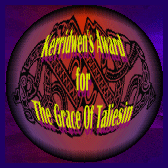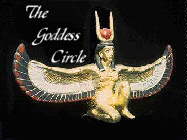


| Introduction | Four: Muses |
| One: Creation | Five: Amazons |
| Two: Descent of the Gods | Six: Women and Religion |
| Three: Goddesses | Conclusion |
THE SACRED MYTH
In the beginning was Woman, and Woman was all. She was the Source of Life, the Primal Creatrix, Mother Earth, Queen of Heaven, the Lady of the Beasts.
In the beginning, fathers were unknown and fatherhood an unknown concept. The connection between sex and procreation is obvious to the modern woman, but was not so obvious to ancient peoples. Women were magical, alluring creatures: they could create life within their own bodies, of their own accord, and draw it forth into the world. They nursed this new life at their breasts, fed this life, clothed it and cared for it. Women were honored as manifestations of the Lady Who supplied the streams and the fish, the trees and the beasts of the hunt, the fields of grain and the fruits of the bough.
For thousands of years, Woman was so honored. Even after the discovery of fatherhood--that the male contributed to the creation of new life--Woman was still revered. This realization was reflected in the faith, art and tales of ancient peoples: a male consort joined the universal Goddess. He can be found in the myths of Aphrodite and Adonis, Isis and Osiris, Anath and Baal, Ishtar and Tammuz, Inanna and Dumuzi, Nanna and Balder, Ix Chel and Itzamna, Olokuktilisop and Olowaipippilele, Hi'iaka and Lohi'au, Papa and Ranga, Quetzaltetlatl and Quetzalcoatl.... For a time, the male creative principle was honored alongside that of the female, though it was often of lesser status: the male principle, expressed as a God, was usually the Goddess' son and consort, sometimes Her brother and consort. But He was always the younger, and, whereas the Goddess was forever and constant, the God often died annually and was resurrected, reflecting the change of the seasons.
Over thousands of years, many human populations moved from nomadism to the settled life of village, town and city. As the life style of the people changed, so their faith changed--men began to assume power over land, livestock, and eventually life. Other peoples, such as those of the Mediterranean and India, were conquered by waves of patriarchal invaders from the Steppes of Asia. The reasons for near-total male assumption of power are unclear and contested by historians, but the results are not: the Goddess was overthrown and the God emerged triumphant. Again, myths and art reflect this transfer of power: the Goddess' virgin forests are violated, She Herself is raped, forced into marriage, forced to show obiesance to the God who had once been her loving and beloved husband/son/consort.
PERHAPS.....
Was there ever such as time and place, an ancient Matriarchy of peace? Was this Golden Age, so popular in women's spirituality texts, a reality? Or is it more accurately a Narrative of Origins? Is it history/herstory or fiction? No subject is more likely to cause heated debate among anthropologists, archeaologists, historians and mythologists than the Golden Age of Matriarchy. Whether or not this was a great age of peace and prosperity, in which war was virtually unknown and nature was honored, remains unclear and dependent upon the personal biases of the interpreter. However, based upon a preponderance of archaeological and mythological evidence, it seems that far in the distant past there was no knowledge of fatherhood, or it was considered irrelevant; family name and property were passed through the female line; and Deity was understood primarily in female form. Historical records, too, seem to support the idea of a time when women were of equal importance and dignity with men, perhaps in some ways of greater importance and dignity, and Goddesses were greater than Gods. Unfortunately, written records appear just as the patriarchal Gods are descending from on high, and reveal the slow and deliberate marginalization of the Goddesses and women, in the forms of sacred myths, folk tales, marriage and property laws, and other legal records.
And what of those myths of Gods battling Goddesses? Some mythographers and historians take the stories at their word, while others consider them allegorical. Most likely, they are a combination of the fictional and the factual, the imaginative and the concrete. While it is doubtful the Greek God Apollo literally slew a giant serpent at Delphi, there is substantive archaeological and literary evidence for an overthrow of the Goddess Gaea at that site, and Her replacement by Apollo--that is, the sacred site of Delphi was violently taken from the priestesses of Gaea and rededicated to Apollo by His priests and priestesses. Similarly, the moon is not the head of Coyolxauhqui--but an Aztec myth recounts a great battle between Deities, in which that Goddess was beheaded; the myth, then, is probably as much a phenomenological tale as the mythological remembrance of a real invasion or civil war.
This change, though, from Goddess to God, was and is far from absolute. The Goddess and Goddesses remained. Among a few peoples the Goddess/es remained all-powerful, but more often survived in altered and marginalized forms. Devi, "Goddess," remains the most powerful expression of Deity among the Hindu faithful. Among Native American peoples, Goddesses remained essential to the life and prosperity of the people and the right order of the universe. Chinese Buddhists revere Kuan-Yin, Mistress of Mercy, as greatly as they do Buddha himself, and Tara is the beloved of Tibet. Natives of the South American Andes, alongside their Catholic Christ and Saints, still honor their mountain Goddesses. Amaterasu-no-mi-kami is still today the life-loving Sun Goddess of the Shinto. The Aboriginal people of Australia never forgot their Ancestresses, who created the world during the long-ago Dreamtime. And the men and women of Africa know wombs will remain empty and fields barren without the blessings of the Goddesses of the hearth and the field, the garden patch and the river.
Even in the West, bastion of male worship, the God's triumph some fourteen hundred years ago was incomplete. Women have long memories. Male historians have regarded as curious relics of the past the sacred stories of Europe and Egypt and the Near East; but to women these sacred stories have long been hidden sources of power. Women remembered that Hera forever fought Her forced marriage to Zeus; they remembered that Freya rode Her cat-drawn chariot across the night heavens; that Danu the Mother was loved from Ireland to Anatolia; that Rana Nedia made the hills green for Saami reindeer; that Medeine ruled the forests of Lithuania and Cerridwen the Cauldron of Inspiration....They remembered that Sarah, Rebecca, Rachel and Leah (and Bilhah and Zilpah) were as much Matriarchs as Abraham, Isaac and Jacob were Patriarchs, that Mary was the Mother of God, that Khadijah was the beloved wife of the Prophet and Fatimah his favorite, powerful daughter.
That, than, is the purpose of Clio. To remember, to reconstruct, to rediscover and to remind those who have forgotten. To remember, reconstruct, rediscover the names and forms and powers of Woman: Goddess, Matriarch, Muse and Amazon. It is from these ancient names and forms of Woman that we draw our strengths and powers, and in them we see all that we have been, all that has been taken from us, all that we have surrendered, all that we can become.
I have collected here some of these stories, only a very few. These are stories of the West and the East, the South and the North. I begin at the beginning, with stories of Creation. Some are very ancient, and recount the creation of the universe; others tell of the annual rebirth of the world. I turn then to the Descent of the Gods, when the Goddess, with all Her names and forms, was overthrown and relegated to a less powerful position. But as the female creative principle never really disappeared from the psyche or tales of humanity, I am also presenting tales of Goddesses and nymphs and other great ones. Rather than being passive observers of the changing order and the world around them, as many historians have assumed, women were active, vibrant and outspoken in an endless number of ways: some chose to express their views and insights through artistry, and so these women are profiled in the chapter entitled Muses; others fought the change, fought the oppression in their own lives and the lives of their sisters and children, and so some of these women are chronicled in Amazons. Finally, a large section is devoted to women and contemporary religion: Judaism, Christianity, Islam, the Baha'i faith, Sikhism, Hinduism, Buddhism, Shintoism, Paganism and Wicca, and the surviving spiritual traditions of the natives of North, Central, and South America, Africa and Australia.
For those who wish to pursue their own research on women, mythology, religion and herstory, a Bibliography has been added. This is by no means a complete listing of all books and links relevant to the subject, but only those of which I have made use or found particularly interesting.
If I offend any devout believer of any faith, then I apologize now. My intention is not to offend, but to inform, entertain and educate. I welcome any criticism or suggestions any reader may have. Any submitted information which I use will be duly credited. Please mail me. And, as always, these sites are under construction, so please be patient.
Back to Table of Contents
To Creation
 |
|
|||
|
 |

 This The Delphic
Oracle site is owned by Grimalkin
This The Delphic
Oracle site is owned by Grimalkin